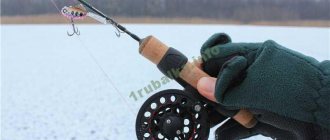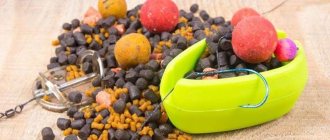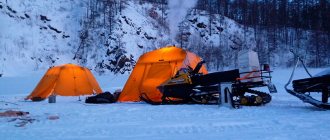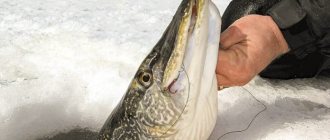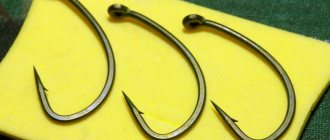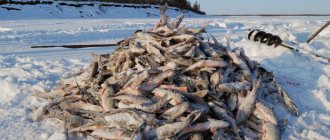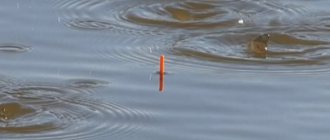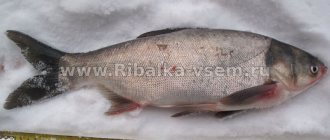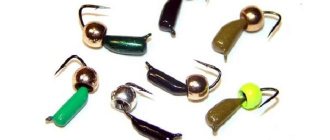Feeder gear is aimed at fishing in open water and with the appearance of ice on still water bodies, fans of the English donkey are sheathing their equipment in anticipation of the first warm days. But favorable conditions for feeder fishing are also possible in winter, because there are rivers with strong currents and production canals with warm water that do not freeze throughout the winter, regardless of the air temperature.
Where to look for fish in winter
If in the warm season the strategy for catching white fish is based on attracting it to a selected point, then the winter feeder involves searching for its parking place. Experienced fishermen claim that 80% of the success of feeder fishing in winter is the correctly found fishing point, so you should pay the utmost attention to marking.
The opinion that during severe cold spells, all fish, except the predator, do not respond to food, is not entirely true, and even at sub-zero air temperatures, fans of the English donkey successfully catch:
- bream;
- roach;
- crucian carp
In winter, bream and bream prefer to camp in places with pronounced unevenness on the bottom of the reservoir, and such points are found almost everywhere where this fish lives. Areas of dense bottom are located at different distances, and there is no universal recipe for finding them; you should “punch” the bottom before fishing and find undercuts and holes in which the fish are kept.
The feeder rod is equipped with a working feeder without a leash and after casting, using the method of dragging and pulling, irregularities are found that are of interest to the fish, and therefore the angler. After irregularities on the bottom are found, the rod is clipped at a given distance, or within a radius of one meter from it. In the river, the food in the feeder is washed out at a certain speed and how much it is carried away depends on the strength of the current.
Bream is also found in places where the bottom of the reservoir is covered with silt, but this happens much less frequently than in areas with changes in height and a hard surface. Feeder fishing in winter is inactive fishing and anglers use not one, but two feeder rods, working them at different distances, increasing the chances of a qualifying catch.
Bites do not happen very often because the fish is still inactive and to get a bite, you need to literally throw the bait under its nose. But the bait should also have an attractiveness that helps quickly attract fish and provokes it to bite.
Winter fishing technique
Working with winter feeder gear is in many ways similar to feeder fishing in open water with elements of fishing with other ice bottom gear. After the fishing location has been determined, the holes and bait have been prepared, we begin the process of fishing on the feeder from the ice.
- We load the feeder with bait, and equip the hooks with a nozzle;
- We lower the rig to the bottom and place the fishing rod on the stand, unwinding the excess fishing line until the nod of the fishing rod is in the alert position.
- We wait for the bite, perform hooking and fishing. If there is no bite for five minutes or more, you should pull out the tackle and reload the feeder.
By analogy with summer feeder fishing, in winter you can also do a preliminary starting feeding of the hole - create a “feeding table”. To do this, the feeder with bait is lowered to the bottom and shaken out by sharply lifting the equipment. This is repeated several times. Instead, starting feeding can be done once, using a large winter feeder such as a dump truck. It is important that your feeder equipment is located in the “table” area.
If fishing is carried out on two fishing rods at the same time, one of them can be equipped not with a feeder feeder, but with an ordinary sinker, the weight of which is slightly less than the weight of loading the feeder.
Winter bait on the feeder
When fishing with a feeder in winter, we recommend using bait based on millet porridge with the addition of different fractions of bulk components. Boiled millet has long been used as bait for fishing with bottom gear, but in the warm season.
It turns out that millet porridge is also effective in cold water, and white bream and large bream respond especially well to it. Instant millet is bought at the supermarket and prepared as indicated in the recipe. After this, the porridge is cooled and additional ingredients are added to it. First of all, these are spicy bulk additives, such as Robin Red or chili pepper, produced by the world's leading manufacturers of fishing food.
Such additives stimulate the fish’s desire to feed and at the same time act as a laxative. The fish absorbs the food and is not satisfied, which forces it to come again and again to the fishing point, where a hook with a nozzle awaits. The additive is used at the rate of a tablespoon of mixture per 200 grams of dry bait. For one kilogram of millet porridge, add a kilogram of factory mixture intended for winter bream fishing in cold water.
Catchy winter baits are offered by Sensas, VDE, Browning, Sonubaits. Among the domestic baits, there are the “Minenko” and “Dunaev/Fadeev” mixtures, developed by professional ground fishermen. At the first stage, store-bought bait should be painted in a dark color, because camouflage of the mixture in clear water is especially important. To do this, use black fishing paint.
After painting and sifting the bait, millet porridge is added to it and, if necessary, additionally moistened. The fine grinding of store-bought bait ensures that the bait mixture will “gather dust” at the bottom of the reservoir, and the dark color camouflages it perfectly. Thus, the result is bait that is correct both in mechanics and in physics, it is inert, and when fishing with a feeder in the winter on a current, this is important.
In 9 out of 10 cases, bream and crucian carp peck from the bottom in winter, and the mechanics of the bait help actively attract fish. And it doesn’t matter whether feeder fishing is carried out in January, December or February, the preferences of the fish in cold water remain unchanged. A simple bait based on millet porridge shows excellent results in winter feeder fishing.
Important!!! Since it is quite difficult to prepare bait on the shore of a reservoir at sub-zero temperatures, make it at home in comfortable conditions and with the necessary physical properties.
How to fish with a winter feeder
The best option would be to select nozzles on the spot. The fact is that the activity of fish is different.
Hooks – you should not take hooks for a winter feeder fishing rod smaller than 14 in size , try fishing first with this one, evaluate how the fish reacts, in the future you can replace it with another one. It is inconvenient to work with small hooks, because your hands begin to freeze and it is problematic to replace especially small specimens or remove caught fish from the mouth.
Interesting fact! Despite the inconvenience, using a small hook can increase the bite, since the bait completely hides it and even cautious fish begin to behave more aggressively. However, in most cases, regular hooks are used.
Also, we should not forget about weight; when fishing in areas with strong currents, you should choose heavier hooks, but if the current is very weak or absent, light ones are quite suitable. This is usually decided on the spot.
The leash – or rather its length. It is also determined during fishing. There are several factors to consider:
- fish activity;
- nozzle size;
- nozzle size;
- nozzle weight;
- the strength of the current.
The initial length is about 40 cm, which will be enough for comfortable fishing . With the activation of the bite, it can be shortened to suit you, for greater convenience.
Gatehouses – a good gatehouse is a must. It helps to contain the current , and if you choose the right angle of immersion, you can feel even minor bites, which greatly simplifies the process.
They do not have to be purchased in stores , but can be made independently at home. For this purpose nods made of spring wire are used ; they are highly sensitive to flow. The main thing is that the fishing line slides over all parts of the homemade gatehouse without resistance.
Choosing a place - the easiest way would be to take a place where holes have already been made; in such places the fish are already partially fed and the bite should be good . If it is not there, you should look for accumulations of fish; this will require drilling holes in different places in the reservoir and checking each one.
If the search takes place on the current, it should be checked step by step. If there is no bite in shallow water, you need to move to greater depths. It is recommended not to sit for a long time without fish, but to look for a suitable site . In both cases, an echo sounder greatly simplifies the task. This is a device that shows schools of fish, but not every fisherman has it.
Fishing technique – in fact, fishing technique is not much different from summer fishing. When the fish is fed and begins to actively peck, the guard signals this. If it twitches slightly, there is no need to rush, but when it decisively goes down, then it’s time to hook.
It should be remembered that not all the fish that bite in this reservoir in the summer will necessarily bite in the winter. During winter fishing you can most often catch bream, roach, carp, crucian carp, and silver bream . Another feature of winter fishing is that not everyone can fish in cold or windy weather; this requires considerable perseverance and endurance.
Rod equipment
Depending on the fishing distance, the length of the rod is selected, and even a mini feeder (or picker) provides convenience when fishing at a close distance of 20–30 meters. If you have to fish long distance, choose a feeder with a height of 3.6–3.9 with a test corresponding to the weight of the feeders used.
In this case, there are also no standard recommendations, and it all depends on:
- features of the reservoir;
- fishing distances;
- weight of the feeder with bait.
A fishing line with a diameter of 0.22 is wound onto the reel spool, because in the cold the cord will become covered with ice, creating obstacles when casting and playing fish.
Bait and techniques for its implementation in winter
The basis of winter bait with a feeder is, of course, a special bait mixture, which I sell in ready-made form. But if it is an under-ice feeder, then there are already special requirements for it.
The strong aroma of bait can greatly spoil fishing. Winter water has a very weak natural odor, so the strong aroma of bait will certainly scare away the fish. Then you will have to either change the place or wait until the bait is washed away by the cold river waters.
Pay attention to the color of the bait. If it is of bright and unnatural colors, it will definitely alert the fish. The food should be dark so that its natural color blends with the river bottom. This will force the fish to look for it, raising a “cloud” of silt from the bottom. Such a process can also attract its other relatives, which can greatly increase the catch.
A winter feeder on ice will be unsuccessful if you do not know the entire mechanism of baiting in strong or weak currents. Such feeds should contain both light and heavy fractions. The light ones will attract the attention of the fish with a trail that is formed by the current, and the heavy ones will simply fall to the bottom, forcing the fish to “rummage” in it, creating a dust “cloud”. For such purposes, use the “100 bites” bait of the Profeeder-river series or the new Ice mixture (for winter fishing).
The latter has the best qualities specifically for ice fishing: it is produced in a ready-made form, does not freeze, the fish really like it, convenient packaging, which has only 0.5 kg and a zip lock (unused bait, closes tightly in the same bag and can be stored for up to next time out on the ice), and if the need arises, it can be tinted. To color the bait, you can use Color paint “100 bites”.
Moistening baits for ice fishing, if it is a homemade mixture, is best done at home. This will save time, since its swelling in cold water lasts much longer than in warm water. But you shouldn’t get too carried away with moisturizing: it should have the properties of plasticine, and disintegrate with some effort.
For a winter feeder on ice to be successful, the feeding must have a well-balanced composition: live animal food must be added to it. To do this, most often they take bloodworms (feed), which can be diluted with soil. Every fisherman knows that the main winter food for fish is animal food, so it is used both live and as an addition to complementary food during winter fishing.
Now you need to decide on the feeding tactics itself. Having decided on the fishing point, they make the first feeding, immediately before “settling in” the fishing spot. While the preparation process is going on, the fish will already be collected. Feeders containing bait with bloodworms are opened at the very bottom of the river so that the feeding “spot” is compact.
And in the process of fishing itself, they supplement the fish. It is made with a special small sports feeder and only bloodworms. It needs to be fed occasionally and in small doses to keep the fish on the “train” of bait. This way you can control the feeding, and with this feeding, the fish will not be overfed and the bait will not be able to scare it. But there are times when the fish leaves, then the first big feeding is repeated in order to attract it again.
Montages used
When fishing with a feeder in winter, it is necessary to use self-tapping rigs and, in particular, an asymmetrical loop, the design of which ensures that the fish is caught even if the angler misses the bite. The equipment is removable and its design features are as follows:
- length of twist with loop for leash – 15 cm;
- loop length 10–11 cm;
- hanging in the loop up to 7 mm.
Unlike the classic asymmetrical installation, where the loop reaches 20 cm, in the winter rig the loop is shorter, which ensures high sensitivity of the rig and the fisherman can clearly see that the fish has taken the bait and needs to hook it. But the bites in winter are accurate, so the participation of an angler who catches the fish is mandatory.
The equipment is tied on a fluorocarbon fishing line with a thickness of 0.16–0.18 mm, which maintains the necessary rigidity and provides camouflage of installation.
How to find a place for a winter feeder
Although in winter the fish is less mobile, even then it does not stand in certain places. Its migrations occur only along certain routes, which is why it is very important to identify such a route on a particular river in advance. Experienced fishermen claim that the under-ice feeder is most successful on the border of a fast and quiet current, which is usually found at the edges along the banks.
A sign of such places can be rocky placers or colonies of shells, because it is in these sections of rivers that food, carried by the current and suitable for fish, lingers. In order to thoroughly study the topography of the river bottom, several holes are drilled across the current from the shore and their depth is measured with a depth gauge, adding them together and representing the topography of the coastal river bottom. The “table” of the river is determined by the channel edge, where there is a sharp transition into depth, beyond which there is an already flat section of the bottom. At the same time, several more holes are made downstream and upstream, determining the presence of longitudinal river edges.
So, the place has been determined, but to start winter fishing, you need to prepare. Usually, two holes are used for this, since this entire process occurs with the help of just one tackle. Complementary food is poured into one hole, and the other, which is located 1.5-2 m from the first downstream, is used specifically for fishing. Moreover, if the ice is very thick, then drilling holes occurs slightly at an angle to the current, as it can interfere with the process. This makes it easier to catch fish and the gear won’t get caught on the edge of the ice.
Feeders for winter feeder
The design and weight of feeder feeders used in winter fishing are responsible for delivering the entire portion of food to a given point. Even when hitting the water, the bait should remain inside the feeder and the dusting effect should be avoided. Plastic mesh feeders are used in weights from 80 grams and above, depending on the fishing range.
Closed-type feeders used for delivering animal components such as bloodworms or maggots to a point are also convenient. But you need to be careful about actively feeding natural baits, because there is a risk of overfeeding the fish and “killing” the point. In addition, there is competition between the groundbait and the bloodworm attachment, which is advisable to avoid.
The function of bait is to attract fish, and the bait becomes an appetizing “cherry on the cake” that neither bream nor crucian will refuse. Plastic feeders are highly buoyant, they are easier to operate at low temperatures and there are no problems with food delivery.
How to make a winter feeder with your own hands
A new fishing rod for winter fishing can be purchased in specialized stores, which are now available in almost every locality . But nothing compares to the pleasure of making this winter fishing tool yourself.
An old broken spinning rod or other suitable materials at hand, for example, handles from “fillies”, are enough. In addition to the creative process, such a homemade product will significantly save money from the family budget.
Important! When making gear, it is worth taking into account the nuances of winter fishing. It will be difficult to catch capricious fish with a rough and insensitive fishing rod.
Hooks
The only element of the equipment that the fish directly encounters are the hooks. Therefore, the fisherman needs to choose hooks in which he will be completely confident. This also applies to:
- wire strength;
- sharpness of the sting;
- reliability;
- forms;
- coloring.
70-80% of fishing success depends on how correctly the hook presents the bait, so when choosing this element of equipment, you should be especially careful.
We recommend hooks from the Owner company, which have long proven themselves to be the best. In terms of price-quality ratio, hooks from this manufacturer are rightfully considered optimal for feeder fishing. For a winter feeder, use Ovner hooks series 53100 and 56535 in number 14. The hooks have a long shank, which facilitates better hooking of fish, and with a long leader (up to 1 meter or more), such hooks turn better in the current.
The hooks are small and light, just the kind you need when catching cautious and demanding fish. Crucian carp or bream should perceive the bait on the hook as natural food and not be afraid to taste it. The light weight of the hook allows the bait to quickly enter the fish’s mouth, and the sharpest sting ensures a high-quality hook. At the same time, bloodworms and maggots are easily put on the above-mentioned hooks, and the bait does not fly off when casting the equipment.
Groundbait and nozzle for ice feeder
The bait for the winter ice feeder is very similar in composition to that used in summer fishing. Only in winter bait there are smaller volumes and fewer different flavors. Almost any winter bait will do. You can use ready-made bait from the store or made according to your own recipes, you can mix ready-made bait and your own.
On the ice of a reservoir, an animal component is added to the bait - bloodworms or mormysh. Moisten the bait so that it stays in the feeder and is not washed out on the way to the bottom, but dissipates within 5 - 10 minutes. A problem can arise when wet bait begins to freeze in the cold. Moistened bait in a pond should be kept warm.
Winter nozzle
Large and medium-sized bloodworms, maggots, jigs, and burdock moth larvae are used as bait for the winter feeder. When catching relatively large fish, several bloodworms are placed on the hook. You can make a “sandwich” by combining different baits on one hook, for example, maggot and three bloodworms. The nozzle is also used as an additive to bait.
Secrets of fishing on a feeder in winter
When fishing on a feeder in winter, large specimens usually bite from the bottom and therefore you need to ensure that the bait is always in close proximity to it.
When using long leashes that slowly sink into the water column, bites from small fish are possible even before the hook with the nozzle sinks to the bottom. To enlarge the catch, shorten the length of the leash, or attach a shot 4-5 cm from the hook, which acts as an additional weight. Pay attention to whether the fish is hooked on the lower lip, because if this is not the case, you need to either shorten the leash (when possible) or install a float shot.
An active bait often scares away large fish in winter and, conversely, attracts small fish. Winter trophies are extremely picky about baits, so keep the bait bloodworms in perfect condition, as well as maggots, if used. The bait on the hook should behave naturally, move and attract fish with its movements.
Additionally, the flavor combinations of the nozzle vary and attractive sprays are used for this. These are liquids with unique aromatic characteristics, containing amino acids and tinted in bright colors, with which the nozzle is sprinkled. Large fish are attracted by the original aroma and provoked to bite.
Winter feeder fishing conditions tend to vary from region to region, but in most cases the use of sprays brings real results and increases the size of the catch. By experimenting with scents, anglers select the ones that work best and thus improve their fishing results. It is not necessary to have a huge selection of flavors, but it is advisable to keep a few popular flavors in a feeder box. Among them:
- anise;
- bloodworm;
- garlic;
- fish combinations;
- hot spices.
Over time, each angler acquires a set of favorite and working flavors that show the best results in his region.
Tactics and techniques of ice fishing in winter
And now the long-awaited trip to the pond, emotions are off the charts. Friends and acquaintances look at my new gear and watch my actions with interest. We decided on the choice of location, the drilling process began and the first feeder with bait sank to the bottom, repeated the feeding procedure several times with the addition of food bloodworms, and here is the long-awaited moment - I hook a 40-centimeter leash, the bait is three bloodworms and one blowfly larva, it’s a long wait for a bite I didn’t have to, in the first minute there was a confident bite clearly visible on the quiver tip, and now I was reeling in my first fish on a rod I made with my own hands, the feeling is indescribable.
There is a small roach on the hook, I take the fish off the hook and put the tackle back into the water and again there is a bite, the fishing started, over time the fish began to get larger and a bream approached. During fishing, it was noticeable that I was catching my friends in the neighborhood with great advantage, and when by lunchtime the fish already refused to bite under my hole due to the constant supply of food, a large flock of bleak gathered, which I successfully caught during the day.
Fishing with a feeder from ice
The concept of an under-ice feeder appeared in the everyday life of bottom fishermen not so long ago, after they tried to use an ice feeder to catch white fish in holes. In such a situation, the advantages of a feeder form when casting equipment are irrelevant, so they use a “mini” feeder equipped with a small spinning reel.
When fishing with standard winter fishing rods at a considerable depth, inconvenience arises when landing the fish, especially if after the bite it has already reeled off a few more meters of line. Delicate fishing with a mini feeder reel brings a lot of pleasure to the angler, and allows you to catch even large carp or silver carp.
Most often, when fishing on an ice feeder, the main target is bream or crucian carp, but catching carp is quite possible, and it is better to catch such fish with reliable tackle. In such cases, all the advantages of the feeder are fully demonstrated, and the angler copes with fish of any size.
Making an under-ice feeder with your own hands is not that difficult, and its main element is the quivertip, which is sensitive to bites from fish of any size.
But the range of fishing products from well-known manufacturers now includes winter feeders for ice fishing, which show excellent results. As an example, let's take Ice Feeder from Salmo. The advantages of an ice feeder appear when fishing in a reservoir with an uneven current and great depth, in conditions where it is impossible to use standard winter feeders. Fishermen have noticed that in winter they catch larger fish on the feeder than on jig tackle; apparently, they prefer low-active baits.
Line selection
For fishing with an ice feeder, use a fishing line with a diameter of 0.14–0.16 mm and fluorocarbon leaders with a diameter of 0.10–0.12 mm. You should not get carried away with fishing lines that are too thin; they do not provide any advantages, but can break at the most inopportune moment. The base must be of high quality, as well as the leading line, so you shouldn’t skimp, especially since you won’t need a lot of line for winter fishing.
The length of the leashes depends on:
- current forces;
- fish activity;
- nozzle size;
- weight.
Hooks for ice feeder
The hooks on the under-ice feeder rig should be inconspicuous and very sharp, instantly detecting the fish. The weaker the current in the reservoir, the less the weight of the hook used should be, but the use of jigs is unjustified. The most popular hooks are numbers 14–18 from the Ovner company.
Feeders
When fishing from ice with a feeder, small feeders weighing 10-40 grams are used. The minimum feeding capacity prevents the fish from becoming saturated with bait, and it will definitely become interested in the bait on the hook. Plastic feeders are more convenient and float up faster from the water column, and closed-type feeders are better; it is more convenient to put bait in them in the cold and it is easier to regulate the rate of its leaching.
Lure
For an under-ice feeder, it is better to use purchased mixtures from Sensas or other trusted manufacturers. There is no point in messing around with homemade bait, because you won’t need much of the mixture, and in winter, as we remember, it is easier to overfeed the fish. The bait needs to be well moistened so that it does not “dust” when the feeder is immersed in the bottom of the reservoir. When fishing at great depths, soil is added to the bait to make the feeder heavier and speed up its descent in the water column.
Tactics and fishing techniques
When fishing in a familiar body of water, fish resting places, deep holes and undercuts are selected, where holes are drilled. If the reservoir is poorly studied, a hole is drilled in an arbitrary place in order to determine the strength and direction of the current and choose the right feeder. In such conditions, exploratory fishing is more logical, so you will have to drill a lot of holes until the most promising point is found.
Preliminary feeding is no more than three feeders, and fishing is carried out with two rods located at a distance of 2-3 meters from each other. The rod located upstream is equipped with a feeder and a leash. The feeder that is located below is equipped not with a feeder, but with a sinker, so as not to overfeed the fish.
The current carries the bait from the upper feeder to the lower one, and it successfully attracts fish. In practice, it turns out that bites on the feeder with a feeder begin earlier, but after half an hour - an hour, the lower rod begins to register bites from fish approaching the feed. As a result, the angler has bites on both feeders, and even if the fish is minimally active, he will not have to freeze.
Important!!! You should not add animal components to the bait and place several bloodworm larvae on the hook. This way you will not overfeed the fish and force it to react to the proposed bait, which it can quickly swallow.
Features of equipment and installation of an under-ice feeder
The most effective winter feeder is for ice fishing in reservoirs with variable currents. Classic stationary springs are not suitable for this, since the behavior of the fish is constantly changing.
So, to fish with stationary springs, the angler needs to make several holes: for springs - above the current, for rods - below. When fishing on a feeder in winter, one hole is enough. The reels used are inertia-free, small in size, with a correctly set friction brake.
Equipment for the ice feeder includes:
- a relatively short fishing rod (about 60-130 cm) with a spinning reel;
- the whip is around 10-15 cm;
- a bright and hard nod (may be absent, in which case the signaling device is a nod);
- stand for winter feeder;
- hook;
- main line;
- feeder;
- leash.
Making your own feeder for winter fishing
Shy fish will not take rough equipment, and delicate equipment often fails. We need balance. It is necessary to ensure that the equipment works equally well on ponds and rivers. A long rod, convenient in the summer, is not used. The fishing rod for the winter feeder should be short with a whip at the end.
A sensitive whip is used for catching small fish, but the tip of the fishing rod when fishing for bream, large roach or carp should be elastic and very hard.
This is what a winter feeder rod for fishing from the ice surface looks like in general terms
Lines used
As a rule, when installing feeder gear for ice fishing, thin monofilament fishing lines with a cross section of 0.14 mm are used. But there are nuances. For catching bream, perch, korop, roach, this thickness is small, so this line is used only as a leash. And the main one is set in the region of 0.16-0.22.
What kind of fishing rod do you need?
Any winter fishing rod of sufficient length will be suitable; it is necessary that they have a durable reel seat and a comfortable handle that does not freeze in the cold and does not slip in the palm. It is also worth paying attention to the rigidity of the whip, since fishing will be carried out using a weight feeder.
Often fishermen equip their fishing rod with legs, on which it is convenient to place the equipment above the hole. Some simply make a small slide out of pieces of ice with a groove in the center; it also serves as a good support for small fishing rods.
A short fishing rod with a hard whip mounted on a stand is a good option for feeder winter fishing
Feeder
When fishing from ice, large feeders designed for summer fishing are not used. Long casting is not necessary, it is undoubtedly easier to overfeed the fish, at the same time they scare away the fish, and the consumption of the bait mixture in winter is much less, unlike in summer.
Feeder bins must be chosen small, otherwise the fish, having become oversaturated, will lose interest in the bait on the hook. In most cases, feeders weighing 10-30 grams are suitable.
A small feeder with a solid filling of bait (without additional holes) is a good option for a winter feeder for fishing in currents and in still waters.
Recommendation: Professional fishermen choose plastic feeders with small diameter holes or without them at all. It is easier to stuff the bait into them with your fingers, and it is slowly washed out by the current.
Equipment and installation of winter feeder
An under-ice feeder involves the use of summer equipment; as a rule, 2 types of installation are used:
- Gardner's paternoster.
Gardner's loop - Asymmetrical loop.
The asymmetrical loop is a little more difficult to perform, unlike Gardner, but much more sensitive. It is used for catching small fish and in reservoirs without current.
Taking into account the fact that the winter feeder is a lightweight version of the summer feeder, all elements of the tackle must be much more delicate, and the loops of the leash and other accessories are much more delicate. This is perhaps the main difference from the summer equipment.
Installation of a winter feeder for flow with an anti-twist tube
How to equip a winter feeder for ice fishing, equipment components and installation features - video instructions:
Hooks
The hook number is selected in the range No. 12-16. Moreover, it is imperative to take into account the size and shape of the bait. Because even if the angler is sitting in a tent, his hands still get cold and it becomes difficult to handle a very small hook.
When choosing hooks, it is also necessary to take into account their weight; it is directly related to the current. If it is strong, heavier ones are knitted, thanks to this they will press to the bottom and stay in place. The choice of hooks can be made already during fishing by installing them of different weights and sizes.
Leash size
Like the hook, the leader size is selected during fishing. It is determined taking into account the following factors:
- presence of current;
- fish activity;
- weight and size of bait.
At first, leashes of approximately 50 cm are knitted, but if active bites need to be shortened, this will make it easier to handle the bait and hook with frozen fingers.
Nod
Winter feeder involves the use of a high-quality gatehouse designed to contain the flow. If the fishing line angle is chosen correctly, the angler will be able to see even a very delicate bite.
Many anglers make sensitive guards themselves. It is important that the fishing line must slide over the entire surface of the lodge without any resistance.
A whip can be used as a nod in feeder fishing!
